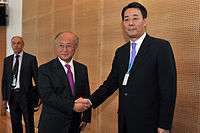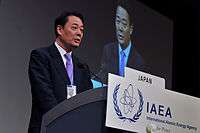Banri Kaieda
| Banri Kaieda | |
|---|---|
| 海江田 万里 | |
.jpg) | |
| President of the Democratic Party of Japan | |
|
In office 25 December 2012 – 14 December 2014 | |
| Preceded by | Yoshihiko Noda |
| Succeeded by | Katsuya Okada |
| Leader of the Opposition | |
|
In office 26 December 2012 – 14 December 2014 | |
| Prime Minister | Shinzō Abe |
| Preceded by | Shinzō Abe |
| Succeeded by | Katsuya Okada |
| Ministry of Economy, Trade and Industry | |
|
In office 14 January 2011 – 2 September 2011 | |
| Prime Minister | Naoto Kan |
| Preceded by | Akihiro Ohata |
| Succeeded by | Yoshio Hachiro |
| Minister of State for Economic and Fiscal Policy | |
|
In office 17 September 2010 – 14 January 2011 | |
| Prime Minister | Naoto Kan |
| Preceded by | Satoshi Arai |
| Succeeded by | Kaoru Yosano |
| Personal details | |
| Born |
26 February 1949 Tokyo, Japan |
| Political party | Democratic Party of Japan |
| Alma mater | Keio University |
| Website | Official website |
Banri Kaieda (海江田 万里 Kaieda Banri, born 26 February 1949, in Tokyo) is a Japanese politician who was the President of the Democratic Party of Japan between 2012 and 2014.
Early life
Kaieda was born and grew up in Suginami, Tokyo. He is named after the Great Wall of China (万里の長城 Banri no Chōjō) as his father was a newspaper correspondent who covered China and Taiwan. He graduated from Keio University where he studied political science, English, German and Chinese.[1] He became known as a television personality in the late 1980s and early 1990s, both in comical roles and as a serious newscaster (hosting the Saturday evening news program on TV Tokyo from 1989 to 1991).
Political career
Kaieda worked as an economic analyst and secretary to a member of the House of Councillors before winning election to the House of Representatives in the 1993 general election. He was originally a member of the Japan New Party, then formed a short-lived party following the JNP's collapse, and was one of the founding members of the Democratic Party of Japan in 1996. He retained a seat in the Tokyo proportional representation block in the 1996 general election, losing his Tokyo 1st district seat to Kaoru Yosano of the LDP. He regained his district seat in the 2000 election and 2003 election, but was forced out of the House of Representatives in the 2005 election, both losing his district seat to Yosano and failing to win a PR seat.
DPJ government


Kaieda re-won the Tokyo 1st district seat in the 2009 general election, following which the DPJ was able to form a government.
Kaieda was tapped to serve as Minister of State for Economic and Fiscal Policy from September 2010, in which role he encouraged the Bank of Japan to purchase foreign currency assets in order to stop a sharp appreciation in the value of the Japanese yen.[2]
In January 2011, he was appointed to head the Ministry of Economy, Trade and Industry by Prime Minister Naoto Kan.[3] The Fukushima disaster in March 2011 made evident numerous missteps within the ministry, and Kaieda stepped down as economy minister in August in order to take responsibility.[4] He had been under intense pressure to resign from the Liberal Democratic Party, and was brought to tears on the Diet floor following 20 minutes of berating from LDP legislator Ryosei Akazawa days earlier.[5]
After Kan resigned in August 2011, Kaieda competed to replace him, supported by former DPJ leader Ichirō Ozawa, then under suspension from the party after being indicted for alleged violation of the Political Funds Act.[6][7] Kaieda lost a runoff vote against Yoshihiko Noda, achieving 177 votes to Noda's 215.[8]
In the 2012 election, the DPJ under Noda suffered a major defeat. Kaieda lost his seat representing the Tokyo 1st district to LDP newcomer Miki Yamada but retained a Diet seat through proportional representation.[9]
Opposition leader
Noda resigned as president of the DPJ to accept responsibility for its defeat in the 2012 election.[10] The resulting DPJ presidential election was held on 25 December 2012, which was contested by Kaieda and Sumio Mabuchi. It was eventually won by Kaieda with 90 votes to Mabuchi's 54 votes.[11] It was suggested that his rise to the leadership could lead to cooperation with Ozawa, who had left the DPJ during 2012 due to Noda's pushing through of a consumption tax increase.[12]
After the 2013 House of Councillors election, in which the DPJ suffered another defeat, Kaieda reportedly approached Naoto Kan and asked him to leave the party.[13]
Despite the DPJ recovering a few seats in 2014 snap election, Kaieda lost his district seat. He resigned as leader of the DPJ[14] and Katsuya Okada succeeded him as president of DPJ.
Views
According to a Gay Japan News 2009 election questionnaire, he supported legalization of gay marriage in Japan and indicated a desire to put support for gay rights into Democratic Party of Japan's party platform.[15]
References
- ↑ 海江田万里「70年代に訪中し、帰国後に夜学で中国語学んだ」 (in Japanese). Searchina. 22 April 2010. Retrieved 26 August 2011.
- ↑ Otsuma, Mayumi (25 October 2010). "Bank of Japan May Consider Buying Foreign Currency Assets, Minister Says". Bloomberg. Retrieved 14 January 2014.
- ↑ Tabuchi, Hiroko (15 January 2011). "Fiscal hawk is named Japan economic chief". Boston.com. The New York Times Company. Retrieved 26 August 2011.
- ↑ Inajima, Tsuyoshi (5 August 2011). "Japan's Industry Minister Kaieda to Step Down After Nuclear Plant Disaster". Bloomberg. Retrieved 14 January 2014.
- ↑ Koh, Yoree (1 August 2011). "The Tracks of Banri Kaieda's Tears". Wall Street Journal Japan Real Time. Retrieved 14 January 2014.
- ↑ Johnston, Eric, "Contenders' backgrounds", Japan Times, 28 August 2011, p. 2.
- ↑ Daily Yomiuri Kan calls it quits / Ozawa expected to support Kaieda, not Maehara 27 August 2012
- ↑ Daily Yomiuri Noda elected DPJ president / 1st-round leader Kaieda undone by support from Ozawa bloc 30 August 2012
- ↑ "山田美樹氏、最後に滑り込み 選挙区で海江田氏破る 東京1区". MSN Sankei News. 17 December 2012. Retrieved 14 January 2014.
- ↑ Mainichi Shimbun PM Noda to quit as DPJ chief after electoral disaster 17 December 2012
- ↑ Daily Yomiuri Kaieda elected new DPJ leader 26 December 2012
- ↑ Japan Times Kaieda takes DPJ helm; Ozawa overture hinted 26 December 2012
- ↑ Martin, Alexander (24 July 2013). "Devastated DPJ Mulls Punishing Ex-PM Kan". Wall Street Journal Japan Real Time. Retrieved 14 January 2014.
- ↑ "Archived copy". Archived from the original on 14 December 2014. Retrieved 2014-12-14.
- ↑ http://blog.goo.ne.jp/forumaquarius2008/e/3e88ed612ee9aa9358164ec8a78d4193
| Political offices | ||
|---|---|---|
| Preceded by Akihiro Ohata |
Ministry of Economy, Trade and Industry 2011 |
Succeeded by Yoshio Hachiro |
| Party political offices | ||
| Preceded by Yoshihiko Noda |
President of the Democratic Party 2012–2014 |
Succeeded by Katsuya Okada |